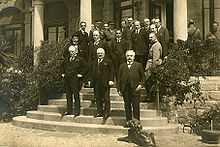Genoa Conference (1922)

The Genoa Conference was held in Genoa, Italy in 1922 from 10 April to 19 May. At this conference, the representatives of 34 countries gathered to discuss global economic problems following World War I. The purpose was to formulate strategies to rebuild central and eastern Europe, particularly Russia, after the war, and also to negotiate a relationship between European capitalist economies, and the new Russian Bolshevik regime (Georgy Chicherin).
Among the propositions formulated at the conference was the proposal that central banks make a partial return to the Gold Standard. The Gold Standard had been dropped to print money to pay for the war. Central banks wanted a return to a gold-based economy for easing international trade and facilitating economic stability, but wanted a form of Gold Standard that "conserved" gold stocks - meaning that the gold remained in their vaults and day-to-day transactions were conducted with the representative paper notes.
This partial return to the Gold Standard was done by permitting central banks to keep part of their reserves in currencies that were themselves directly exchangeable for gold coins. However, citizens under this new Gold Exchange Standard (also known as the Gold Bullion Standard or the Inter-war Gold Standard) would not receive gold coins of the realm in exchange for their notes, though this had been an integral part of the original Gold Standard now known as the Gold Coin Standard.
Under the Gold Bullion Standard, citizens of Britain and other European countries could only redeem their banknotes in large gold bars. Such bars were unsuitable for day-to-day transactions, but largely achieved the goal of keeping the gold in the vaults.
References
- Encyclopædia Britannica - http://www.britannica.com/eb/article-9000832
- The Stability of the Inter-war Gold Exchange Standard - http://mauricio.econ.ubc.ca/pdfs/kirsten.pdf
- Ludwig Von Mises Institute - http://mises.org/money/4s3.asp